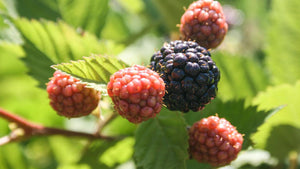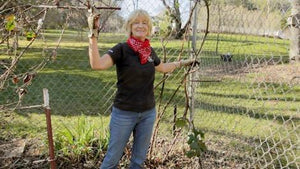Item Number: FV324
Boysenberry (Potted)
Thorned Variety, Perfect for Animal Deterrence
Mix-and-match 4 or more potted berry plants for free shipping!
Boysenberries (Blackberry Rubus) are a classic and beloved variety known for their large, dark purple fruit, offering a perfect balance of sweetness and tartness. Widely grown across the United States, the boysenberry is especially cherished for its versatility—perfect for eating fresh, baking into pies and cobblers, or making rich preserves.
The boysenberry plant thrives in full sun and well-draining soil, producing abundant harvests in mid-summer. With a trailing growth habit, it benefits from trellis support to improve fruit production and make harvesting easier. Originally developed in southern California, near Anaheim, California, the boysenberry rose to fame thanks to Walter Knott of Knott’s Berry Farm. Today, it remains a favorite among home gardeners and berry lovers alike.
Whether you're growing a backyard berry patch or looking for a boysenberry plant for sale, this flavorful and productive fruit is an ideal addition to your garden.
Potted Boysenberry
Zones: 6-9
Harvest: mid-June to early July
Fruit: Large, long fruits that ripen to a deep maroon. Juicy, sweet-tart berry with a delightful aroma.
- Facts of note: Perfect for freezing, canning, jams, jellies, and eating fresh. Boysenberries were developed from European raspberries and three different varieties of native blackberries. Needs protection below 10°F. Boysenberries are the fruit that made Knott's Berry Farm of Buena Park, California famous. This potted boysenberry variety features thorned canes, offering a traditional berry-growing experience.
- Plants are 2 years, grade #1Boysenberries
Esteemed for their large, sweet-tart fruit, thrive within specific parameters that cater to their growth and fruitfulness. Delving into the nuances of cultivating these berries reveals a process that requires attention to detail and a grasp of their unique needs.
Understanding the Basics:
Boysenberries, scientifically known as Rubus ursinus, are ideally suited for Zones 6-9. Bearing fruits from mid-June to early July, these berries boast elongated shapes and mature to a rich maroon hue. Their flavor is a delightful blend of sweetness and tartness, accompanied by an inviting aroma.
Origins and Development:
Rudolph Boysen, George Darrow, and Farmer Walter Knott play significant roles in the history of boysenberries. This fruit resulted from the crossbreeding of European raspberries and three distinct varieties of native blackberries. Farmer Walter Knott's cultivation of boysenberries at Knott's Berry Farm in Buena Park, California, contributed greatly to their popularity.
Ideal Conditions:
Boysenberries demand careful attention to their environmental needs. They flourish in well-draining soil and require protection when temperatures drop below 10°F. Full sun exposure aids their growth, although they also appreciate some shade in scorching climates. Adequate air circulation is crucial to prevent fungal diseases.
Planting and Care:
Planting two-year-old, grade #1 boysenberry plants sets a solid foundation for growth. Ensure proper spacing, usually 4-6 feet apart, allowing the plants ample room to spread and thrive. Regular watering is essential, especially during dry spells, while mulching helps retain moisture and regulate soil temperature.
Pruning and Maintenance:
Pruning is pivotal for boysenberries. Removing dead or diseased canes and keeping the growth controlled ensures better fruit production. Prune during the dormant season, and be cautious, as they bear fruit on second-year canes.
Pollination:
Boysenberries are self-pollinating, though additional nearby plants can enhance pollination and fruit set. Encouraging pollinator-friendly flora in the vicinity can attract beneficial insects and aid in the pollination process.
Comparison to Other Berries:
Boysenberries are large, dark maroon or purple berries with a sweet-tart flavor, a hybrid of blackberry, raspberry, and loganberry, growing on trailing vines. Raspberries are smaller, come in various colors like red, black, purple, or golden, and have a sweet, aromatic taste, growing on canes and being more cold-hardy. Loganberries, a hybrid of blackberry and raspberry, are dark red or deep purple with a slightly tart taste, growing on vigorous trailing vines.
Harvest and Usage:
Harvest boysenberries when they reach full ripeness, displaying their deep maroon color and easily detaching from the vine. Their versatility allows for various culinary uses, including freezing, canning, making jams, jellies, or simply relishing them fresh. Proper storage in the refrigerator prolongs its shelf life.
Boysenberries stand as a testament to meticulous cultivation, offering a delectable fruit known for its versatility and unique flavor profile. By providing them with the right conditions and care, growers can enjoy bountiful harvests and relish the fruits of their labor.
For more information, please enjoy our Growing Guide for planting and growing cane berries.
Visit our Berry, Vine & Crowns Characteristics Chart to compare growing characteristics for all our berries, vines, and crowns.


Check Your Zone Compatibility:
Compatible with your zone.
Growing Zone for

Our Guarantee To You
Since 1976, we've served our customers at every stage of growing. Please contact us at any time. We are happy to support and assist you.
Shipping Information
Shipping Information
Cannot ship to the following states: HI, AK, PR, GU, VI
Cannot ship via USPS.
Cannot ship via SmartPost.
Shipping Weight: 2.0 lb
Dimensions: 35.9"L x 3.9"W x 3.9"H
Features
Features
- Grow on a Trellis
- Potted
- Self-fruitful
- Suited to Warmer Climates
Characteristics
Characteristics
Planting & Care
Planting & Care
Useful Information
Useful Information
Guarantee
Guarantee
We guarantee the perishable items we sell to be in good, viable condition when we sell them. Perishable items include, but are not limited to, garlic bulbs, flower bulbs, seed potatoes, onion sets & transplants, potted or bare root trees, vegetable crowns, etc. If your perishable item arrives in substandard condition, take photographs and please contact us within 3 days of the purchase date (or delivery date) and we will provide you with a refund of the purchase price (excluding shipping costs), or a replacement. Accordingly, we urge you to open any boxes marked as ""Perishable"" immediately upon receiving them and inspect the shipment thoroughly (do not crack open heads of garlic, we do not accept claims on cracked garlic). Because some perishable items can deteriorate very quickly, we cannot accept any claims beyond the 3-day time frame as it becomes too difficult to determine if these items were delivered in substandard condition, or if they turned into such substandard condition because of having been improperly cared for or stored once delivered.
Share

I planted these maybe a week after they arrived. All four have new growth and one has a berry. I’m not very good with plants (most die within a year of purchasing) so the new growth is definitely encouraging.
I bought a one boysenberry bare root plant and an very happy with my purchase. At first I was not sure if it would grow as it was just a 🌱 stick and know oh my it's so big and getting bushieee🤭 can't wait to taste the fruit. What a great addition to our backyard.. 😊
Bought 50 thrones boysenberry plants, great price! Never before had such complete instructions on acclimating the plants! Doing a slow-acclimation now with a root-stimulator diluted B1 vitamin mix to adjust to the warming Southern Orange County climate. Great job Peaceful Valley!
Received these a week ago with lots of new growth already started. I've tried ordering bareroot berry plants in the past & they never made it. These on the other hand are acting like nothing ever happened to them. Can't wait for them to start producing fruit.
Boysenberries produced abundantly without any pests or problems. They seem to be a no fuss no muss berry. Delicious flavor - very sweet and juicy.




